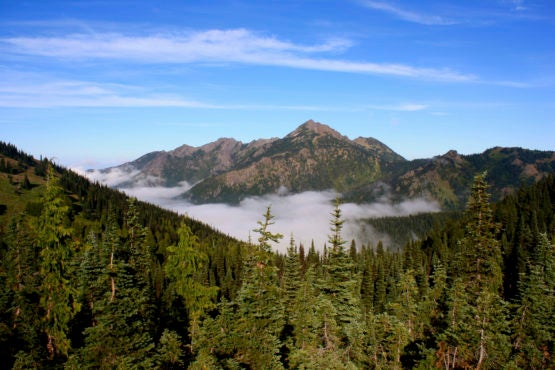Is An Earthquake A Rapid Or Slow Change
Stanford researchers explain earthquakes nosotros can't feel
Researchers have explained mysterious slow-moving earthquakes known as slow sideslip events with the help of computer simulations. The respond, they learned, is in rocks' pores.
The World's subsurface is an extremely agile place, where the movements and friction of plates deep surreptitious shape our landscape and govern the intensity of hazards above. While the Earth's movements during earthquakes and volcanic eruptions take been recorded by delicate instruments, analyzed by researchers and constrained by mathematical equations, they don't tell the whole story of the shifting plates beneath our feet.

Slow slip events ofttimes occur in subduction zones, such equally the one below Olympic National Park that stretches from Northern California to the Pacific Northwest. (Epitome credit: Alisha Bube/iStock)
Over the past two decades, the advent of the global positioning organization – including receivers with extremely sensitive sensors that capture millimeters of motility – has made scientists aware of convulsion-similar phenomena that have been challenging to untangle. Among them are so-called slow sideslip events, or slow-moving earthquakes – sliding that occurs over weeks at a time unbeknownst to humans on the surface.
These slow slip events occur all over the globe and possibly help trigger larger earthquakes. The largest irksome slip events occur in subduction zones, where one tectonic plate dives beneath another, eventually forming mountains and volcanoes over millions of years. New reckoner simulations produced past researchers at Stanford University and published online June 15 in the Journal of the Mechanics and Physics of Solids may explain these subconscious movements.
"Slow slip is such an intriguing phenomenon. Slow slip events are both then widespread and really and so unexplained that they're a puzzle that dangles before u.s. as scientists that we all want to solve," said study co-writer Eric Dunham, an associate professor of geophysics in Stanford's School of Earth, Energy & Environmental Sciences (Stanford Earth). "Nosotros've known well-nigh tedious slip for nigh 20 years and there'due south still not a great agreement of why it happens."
Stealthy only potent
These events are particularly challenging to explain because of their unstable simply sluggish nature. The fault does not slide steadily but instead, sliding periodically, accelerates, notwithstanding never reaches the bespeak where information technology sends out seismic waves large enough for humans to discover.
Despite their stealthy nature, slow slip events can add up. In an ice stream in Antarctica, the slow slip events occur twice daily, last xxx minutes and are equivalent to magnitude vii.0 earthquakes, Dunham said.
Researchers think changes in friction explain how apace stone on either side of the fault slips. With that in mind, they assumed slow sideslip events started as earthquakes, with a blazon of friction known equally rate-weakening that makes sliding fundamentally unstable. Merely many laboratory friction experiments contradicted that idea. Instead, they had institute that rocks from slow slip regions brandish a more stable kind of friction known every bit rate-strengthening, widely thought to produce stable sliding. The new calculator simulations resolved this inconsistency past showing how wearisome skid tin ascend with opposite-seeming charge per unit-strengthening friction.
"A scattering of studies had shown that at that place are ways to destabilize rate-strengthening friction. Still, until our newspaper, no 1 had realized that if you false these instabilities, they actually plow into tiresome skid, they don't turn into earthquakes," co-ordinate to lead author Elias Heimisson, a doctoral candidate at Stanford Earth. "We too identified a new mechanism for generating slow sideslip instabilities."
Laws of physics
Dunham'due south research group approaches unanswered questions near the Earth by considering all the possible concrete processes that might be at play. In this case, faults occur in rocks that are saturated in fluid, giving them what's known as a poroelastic nature in which the pores permit the rock to expand and contract, which changes the fluid pressure level. The group was curious about how those changes in pressure can change the frictional resistance on faults.
"In this case, nosotros did non start on this project to explicate slow slip events – we started on information technology because we knew that rocks have this poroelastic nature and we wanted to run across what consequences it had," Dunham said. "We never thought information technology would give ascent to slow skid events and we never thought it would destabilize faults with this type of friction."
With these new simulations that account for the rock's porous nature, the group institute that equally rocks get squeezed and fluids cannot escape, the pressure increases. That force per unit area increment reduces friction, leading to a tedious sideslip event.
"The theory is high-level," Heimisson said. "We come across these interesting things when you account for poroelasticity and people might want to use it more broadly in models of seismic cycles or specific earthquakes."
Heimisson will exist creating a 3D simulation based on this theory equally a postdoctoral researcher at the California Institute of Engineering science.
Martin Almquist, a postdoctoral research fellow in the Department of Geophysics, is a co-author on the written report.
The enquiry was supported by the Stanford Consortium for Induced and Triggered Seismicity, the Southern California Earthquake Center, NASA Headquarters under the NASA Earth and Space Science Fellowship Program and the Knut and Alice Wallenberg Foundation.
To read all stories about Stanford science, subscribe to the biweekly Stanford Science Digest.
Source: https://news.stanford.edu/2019/08/21/new-theory-explains-earthquakes-cant-feel/
Posted by: ballardloffinds.blogspot.com

0 Response to "Is An Earthquake A Rapid Or Slow Change"
Post a Comment